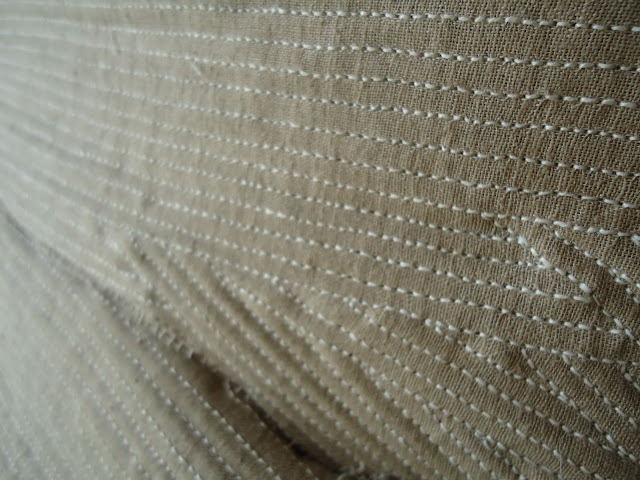Bias Discussion on Corset Side Front Panel
 |
| Jil Salen p.13 |
Jil Salen, in her book 'Corsets - Historical Patterns and Techniques' lays her Side Front Panel neatly on the grain.(see page 13)
On the very next page she notes on another corset: "...using the grain of the fabrics to flow around the body and support the bust." (see page 15)
Norah Waugh, famous for 'Corsets and Crinolines', lays her 1730-40 corset on the grain (see page 39).
She also uses Diderot's drawings from his pamphlet ' Le Tailleur d'Habits et Tailleur de Corps' but although detailed - this does not show which grain the actual fabric has been placed on - only the positioning of the bones, nor in the description based on his leaflet on how to make the stays up, does it mention where the grainline lies. (see pages 152 for the drawings and p.153, under the heading 'Eighteenth Century Stay' or the description in Corset and Crinolones.)
It's a terrible photo but, when cutting out my corset, I diligently placed it on the grainline and boy, does it help with the stitching and getting a neat straight line. BUT....
Going back over my photo's from my research sessions at The Bath Fashion Museum, and zooming into the photos, the grain lines for two of the corsets where I could get a good clear image of the weave of the fabrics, neither go along with the sweeping lines of the Side Front Panels.
If this works, I've uploaded the photo's in it's original size so you might have to scroll along but the weave of the linen should be clear enough for you to be able to trace the grain line for yourself.
I've also included a smaller image of the photo so you can see what you're looking at as a whole.
Here's BATMC 1.27.85, dated 1775-80.
 |
| (Images Courtesy of The Fashion Museum Bath and North East Somerset Council) |
Image Courtesy of the Fashion Museum, Bath and North East Somerset Council.
The next corset is BATMC 1.27.865 and dated 1700-1799.
 |
| Image Courtesy of the Fashion Museum, Bath and North East Somerset Council. |
And again, here's a smaller image.
 |
| Image Courtesy of the Fashion Museum, Bath and North East Somerset Council. |
You can see from the larger image that the grain line for this particular corset actually follows the 3rd tab (the one next to the Side Back Panel) but this seems to be the only place where it does.
I wonder about this really.
Staymaking was such an art, skill and exact science in every other aspect, that it doesn't seem likely that it was just not an important issue where the grain lay and that they just placed it anywhere. Although I admit we can't really rule this out.
What is interesting is, even while neither of the corsets from the Bath Fashion Museum match, they do echo each other: ie, the grainline running roughly with the tab closest the Side Back Panel and pushing towards (if you can imagine it) the top of the CF join.
Or using Jil Salen's image again...
roughly (and very roughly as this is a slightly different pattern shape) in this position. Although I'd say the pattern and shape of the Side Front Panel of the two from the Bath Fashion Musuem were much wider and the tab set much more to the left so that the arrow could be angle a bit more pointing to the CF top corner. But this image was really only used as a tool to be able to describe it clearly.
This post wasn't really supposed to come to any conclusion but just lay out what I've found and that it is an interesting issue and one to be continuously researched.
I guess the next worthy step would be to visit the Colchester and Ipswich Museum and see if the corset Jil Salen uses on p.11 of her book 'Corsets' could be viewed. And if it could, then there'd be plain evidence which way the grain lay. Norah Waugh doesn't mention which corsets she bases her patterns on from pages 38-44 so there's no way to verify hers.
If anyone else out there has close up images of corsets from this period and would be interested in looking at which way their panels run, I'd be most interested for your feed back.



No comments:
Post a Comment